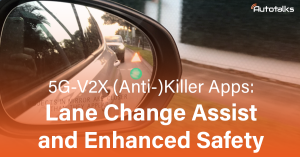By Sagit Adler
“V2X can save lives by enabling wireless communications among vehicles, roadside infrastructure, and mobile devices” is stated in the USDOT’s plan to accelerate V2X deployment.[i] V2X is undoubtfully a solution that can save the lives of thousands of people on the road by providing alerts to drivers regarding upcoming road dangers. The technology has been around for over a decade, so why don’t we see this technology in every vehicle and stop light? The answer lies in the challenge of initiating widespread adoption—a classic chicken and egg dilemma: how can the technology gain traction without significant penetration? Each region faces unique obstacles, but here’s how we can tackle this issue:
- Prioritize Deployment in Commercial Vehicles: Semi-trailers and other large trucks can be the first to be equipped with V2X. In accidents between trucks and other vehicles, the truck is likely to cause great damage. According to statistics from the United States Department of Transportation, about 11% of all fatal motor vehicle crashes in 2019 involved large trucks[ii]. Equipping them with V2X technology is relatively cost-effective compared to the potential damage they can prevent.
- Empower Vulnerable Road Users (VRUs): Micromobility users, such as cyclists and motorcyclists, stand to benefit greatly from V2X. Their limited physical protection makes them more susceptible to accidents, making them willing adopters of safety technologies.
- Implement Smart V2X Intersections: Smart V2X intersection, which combines several sensors including V2X, camera and radar, can make a real impact. Their capabilities include features such as the detection of Vulnerable Road Users and vehicles which are not part of the V2X network. Equipping traffic lights in strategic locations with this technology can incentivize wider V2X adoption.
- Utilize NCAP Grading: NCAP grading is an effective way to push OEMs to equip new cars with V2X. China NCAP adopted V2X for the safety score of vehicles starting in mid-2024.[iii] Incorporating V2X into safety evaluations, as China NCAP has done, incentivizes OEMs to integrate the technology into new vehicle models. Expediting this process in regions like Europe and the US can significantly boost V2X deployment.
- Advocate for Regulation: Regulatory mandate is the ultimate force driving V2X adoption. While past efforts in the US have faltered, like the attempt during the Obama administration, renewed focus on regulation[OH1] can propel the technology forward. A similar mandate should also be extended to Europe, where the European Commission recognizes the urgency to deploy V2X.
- Manufacturers’ Deployment Commitment: In the past, there have been numerous collective letters expressing the industry’s commitment to deploying V2X in an agreed number of vehicles within a certain number of years. While previous efforts may not have yielded significant results, issuing another letter like this might not be the optimal solution to break the chicken and egg cycle, but it could be a step in the right direction.
In summary, there are numerous methods to facilitate V2X deployment and significantly reduce road accidents. Encouragingly, the USDOT plans to equip 25% of all major intersection with smart infrastructure by 2026, with many more deployment planned in the following years.[iv] This offers hope for breaking the cycle of hesitation surrounding V2X adoption. With continued efforts, safer roads may soon become a reality for all.
[i] https://www.its.dot.gov/research_areas/emerging_tech/pdf/Accelerate_V2X_Deployment.pdf
[ii]https://crashstats.nhtsa.dot.gov/Api/Public/Publication/813060#:~:text=There%20were%2036%2C096%20people%20killed,2018%2C%20or%20739%20fewer%20fatalities.
[iii] https://itsa.org/wp-content/uploads/2024/02/ITS-America-V2X-Decoded-Final_2.24.pdf
[iv] https://www.its.dot.gov/research_areas/emerging_tech/pdf/Accelerate_V2X_Deployment_summary.pdf








